

Name: Luis Arpa
Location: Indonesia
“This is an image of a juvenile Pinnate Batfish captured using a slow shutter speed, snooted light, and deliberate camera panning to create motion and drama,” says Arpa Toribio. “Juveniles are known for striking black bodies outlined in vibrant orange — a coloration lost within months. I encountered this restless subject in the tropical waters of Indonesia’s Lembeh Strait. Capturing the image required patience and persistence over two dives, as these active young fish constantly dart into crevices for cover, making the shot particularly challenging to execute without interfering with the fish’s natural behavior.”
Oceanographic Magazine has sifted through thousands of entrants and narrowed down the finalists of its Ocean Photographer of the Year contest. Presented together with Blancpain, the competition celebrates the beauty of our ocean and highlights why it must be protected at all costs.
The 2025 finalists are spread across seven categories that include everything from photographs of extraordinary wildlife to a look at the environmental impact humans have on the ocean. The winners will be selected from this exceptional list and announced in September.
“In the midst of a deepening climate and biodiversity crisis on our blue planet, ocean photography has never been more important,” shares Ocean Photographer of the Year Director, Will Harrison. “These images are far more than just beautiful — they are powerful visual testaments to what we stand to lose, and they remind us of the urgent need for protection. Ocean Photographer of the Year continues to be a vital platform for sharing critical stories from above and below the waterline.”
With big names like Alvaro Herrero, Henley Spiers, and Scott Portelli in the mix, the competition is stiff. Some standouts include Kaushiik Subramaniam’s aerial image showing gray whales in Baja, California, cozying up to a fishing skiff and Karim Iliya’s look at a windsurfer braving the waves in Maui. These images, which are finalists in the Human Connection and Adventure categories, respectively, are just a sample of the high-quality photographs in the running for the top prize.
Scroll down to see some of our favorite finalists and then head over to the Ocean Photographer of the Year website to see the full gallery of 2025 finalists.
The 2025 Ocean Photographer of the Year contest has announced its finalists.


Name: Romain Barats
Location: Antarctica
“It’s amazing how fast gentoo penguins are able to build a colony during the austral summer in the Antarctic peninsula,” says Barats. “Port Charcot is usually a good place for this. This sheltered bay surrounded by mountains and icebergs is a perfect base for gentoos. We anchored our sailboat in this bay for three days, near the colony. We got in the water every day to enjoy the spectacle of these highly curious birds, who came to check on us so many times. Clumsy on land, these birds are fast and agile in the water.”
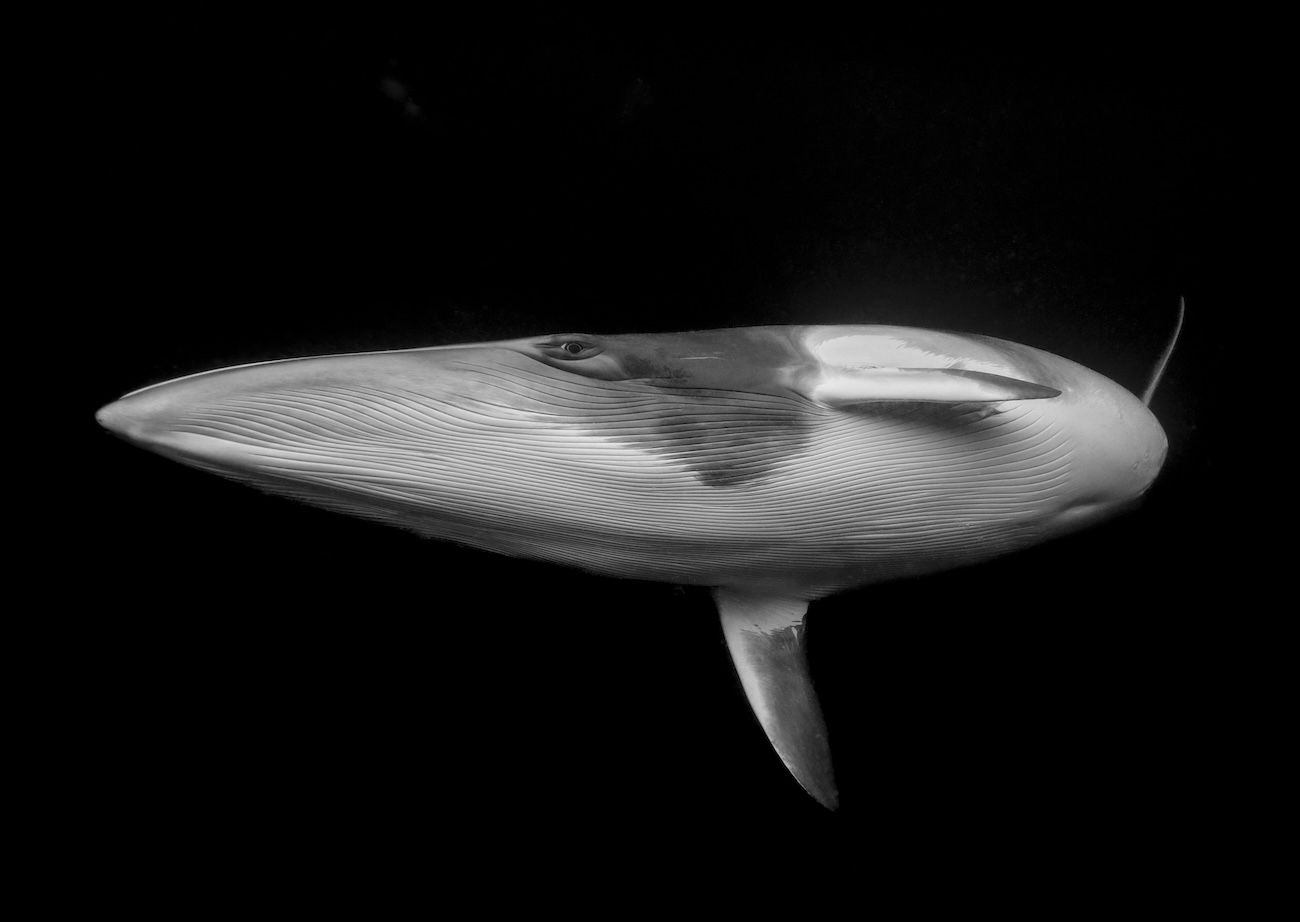

Name: Marcia Riederer
Location: Australia
“Dwarf minke whales are known to visit the northern Great Barrier Reef during the winter, making it the only known predictable aggregation of these whales in the world,” says Riederer. “These curious giants approach swimmers with an almost playful curiosity. Floating in the turquoise water, watching a sleek, dark body glide effortlessly towards you, its eye meeting yours in a moment of connection. The whales, seem to acknowledge your presence, circling and interacting with you. It’s a humbling experience, reaffirming the wonder of the ocean and its inhabitants, and the urgent need to conserve it.”


Name: Toni Bertran Regas
Location: Spain
“I’ve always been fascinated by the resemblance between jellyfish and space rockets,” says Bertran Regàs. “I was looking for a photograph that conveyed that connection: a rocket leaving Earth. To do this, I used a fisheye lens and took the photo just as the sun was rising. Snell’s Window helped me create the Earth, the particles were the stars, and the sun luckily appeared behind it. I don’t think I’ll ever be as close to space as I was that day.”


Name: Hitomi Tsuchiya
Location: Japan
“This image was taken near Mount Iwo on Satsuma-Iojima Island, where the underwater aurora can be seen,” says Tsuchiya. “The volcano spews out iron-rich substances not only from above ground but also from the ocean floor, creating these rich colors. I hope this images pushes people to think about the connection between global warming and marine conservation. We must preserve these mysterious and fantastical landscapes, created by land and sea, for future generations.”
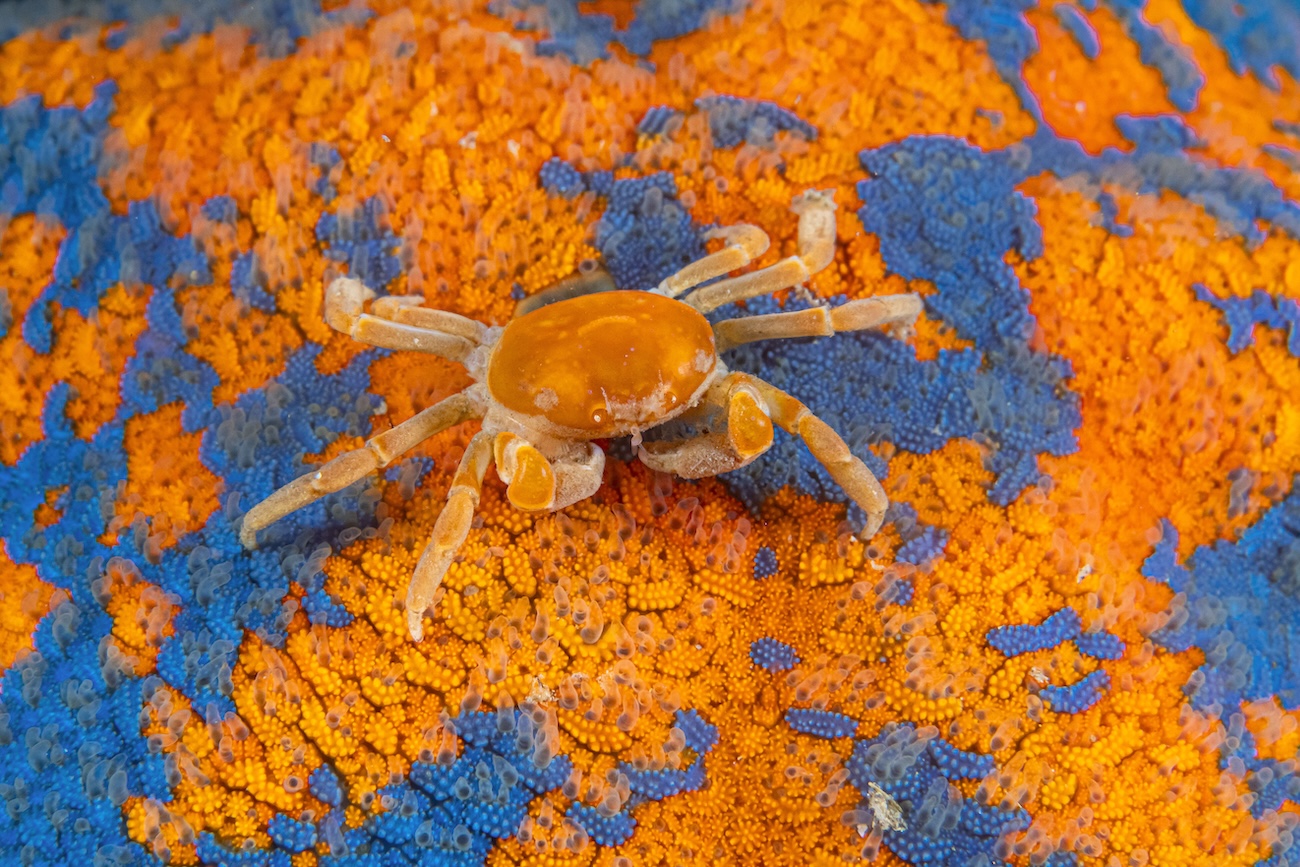

Name: Andray Shpatak
Location: Russia
“I’ve been diving in the Rudnaya Bay area for more than 40 years, but I’ve never seen a pea crab,” says Shpatak. “I was lucky. Pea crabs spend most of their lives inside the shells of grey mussels, a symbiotic relationship that only ends when the mussel or crab dies. I can only assume that this pea crab was looking for a home when I managed to photograph it.”
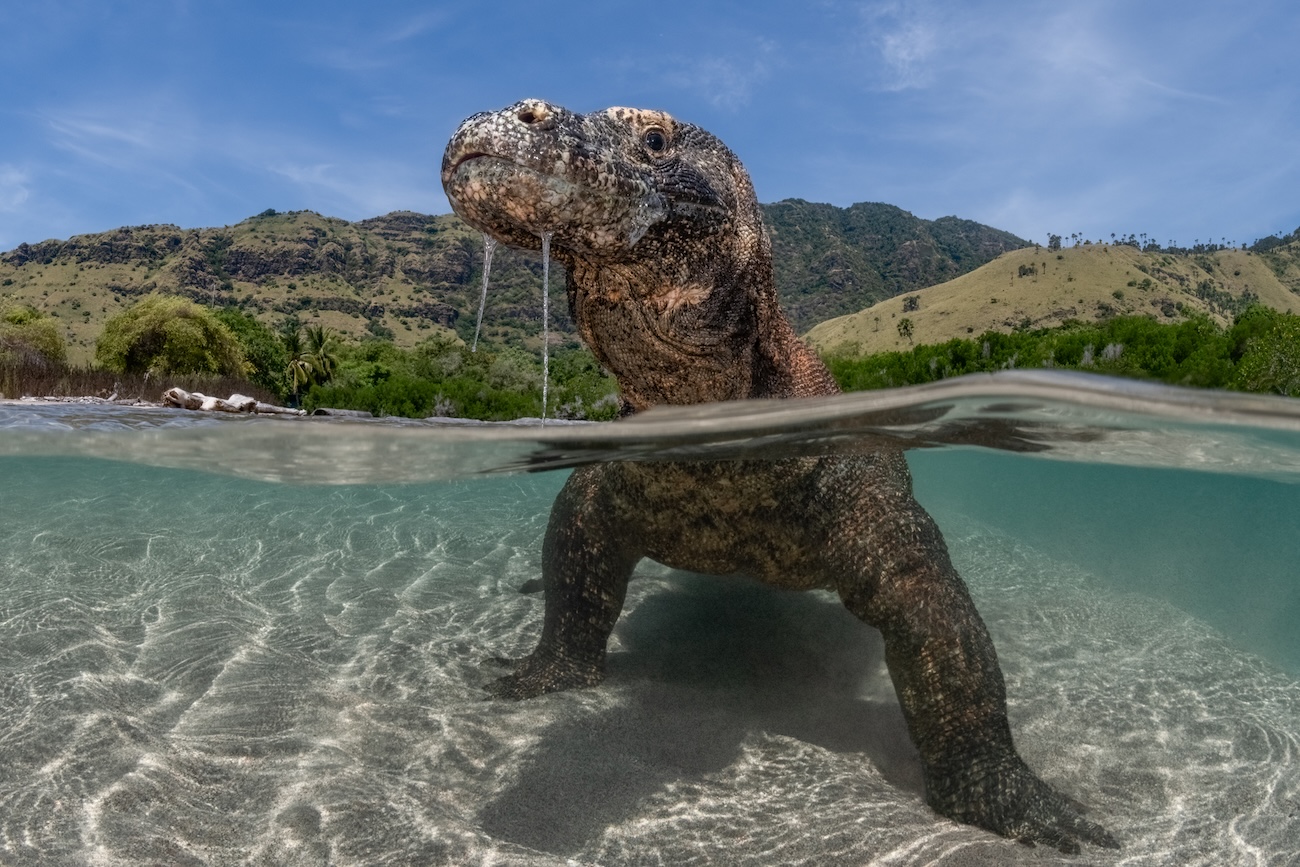

Name: Suliman Alatiqi
Location: Indonesia
“This photo was captured after extensive fieldwork with the support of local rangers,” says Alatiqi. “Our focus was to shed light on the Komodo dragon’s interaction with one of its main—yet commonly overlooked—habitats: coastal shorelines. As cold-blooded animals, Komodo dragons rely on external sources to regulate their body temperature. During the scorching heat, they can be seen resting in shallow water or mud to lower their body temperature. As adept swimmers, they will also swim or walk across the seabed to expand their territorial search for food or mates.”
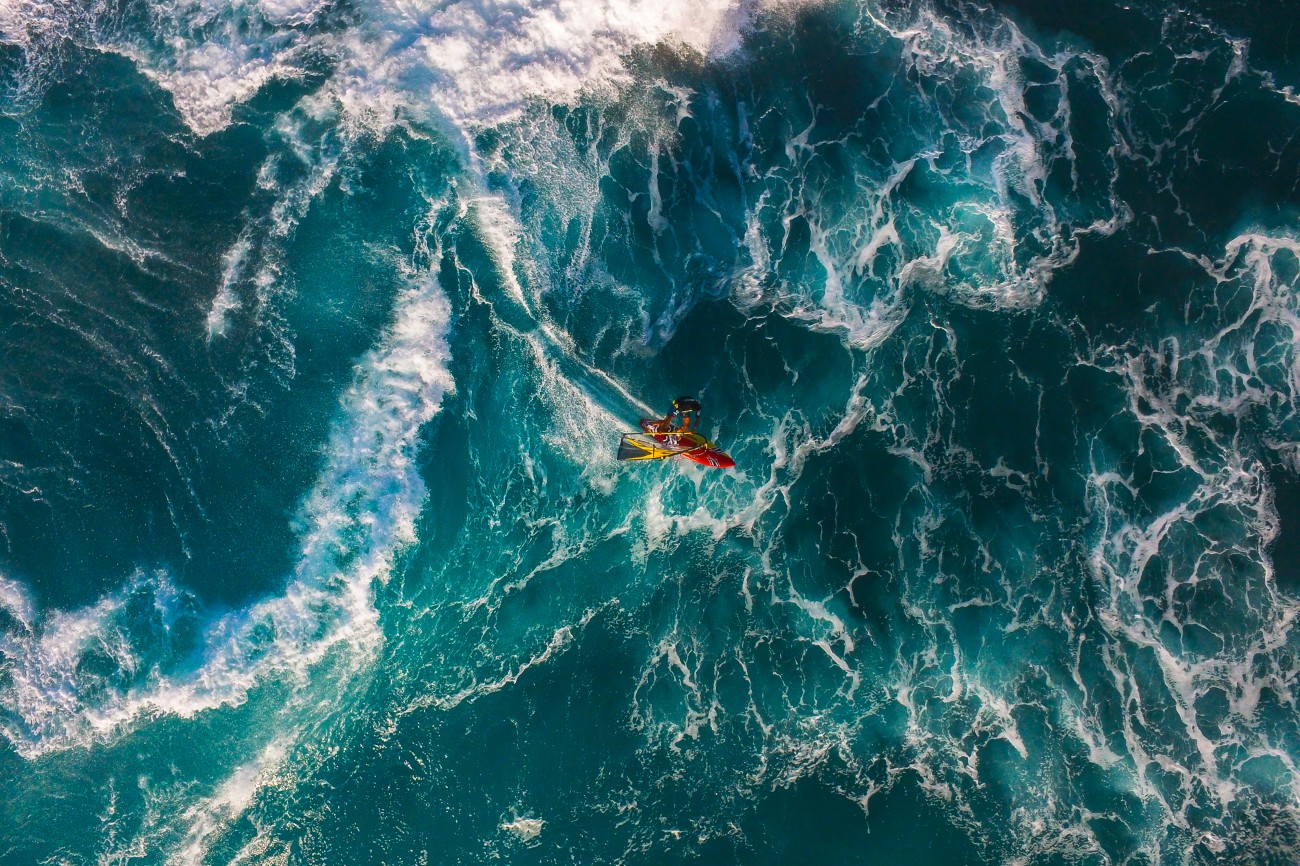

Photographer: Karim Iliya
Category: Adventure
Location: Hawai’i
“This photo shows a windsurfer riding a wave at Ho’okipa Beach in Maui, a spot famous for its big waves and strong winds,” says Iliya. “Taken from above with a drone, the image offers a unique look at a sport most people rarely get to see up close. The photo was captured during the American Windsurfing Tour competition, where some of the best windsurfers in the world come to test their skills. From this aerial view, you can really feel the power of the ocean and the connection between the rider, the wave, and the wind driving it all forward.”
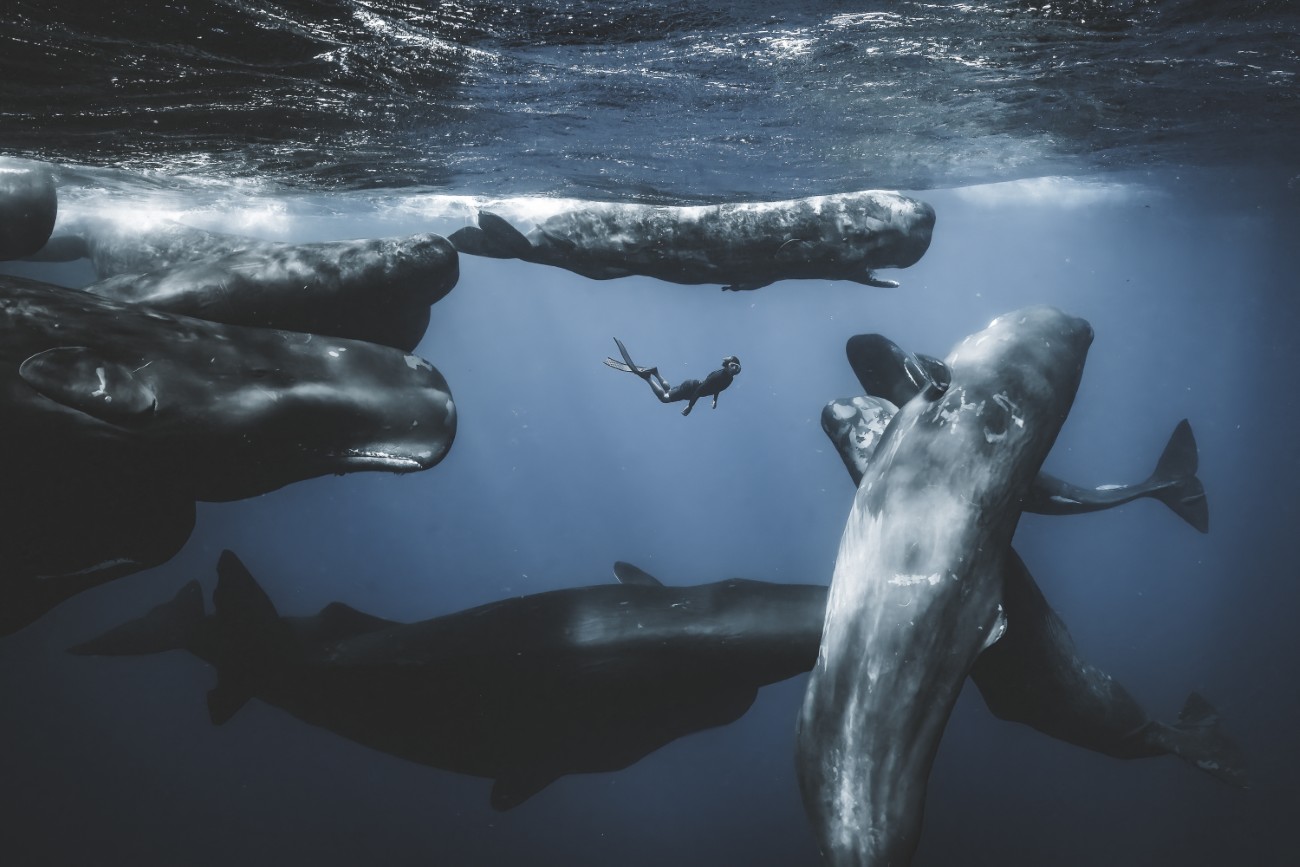

Photographer: Romain Barats
Category: Adventure
Location: Dominica
“I’ve been fond of whales since my childhood, so I was really excited to get the opportunity to swim with sperm whales for the first time in my life,” says Barats. “I was extremely lucky on my first day at sea. We saw 15 whales socialising for 45 minutes or so. The sea was rough but when you get to see something like that you quickly forget the conditions. There were three of us in the water, spread out due to the action. The whales began to move out when I suddenly saw my buddy freediving from afar. I managed to get a shot of him surrounded by whales.”
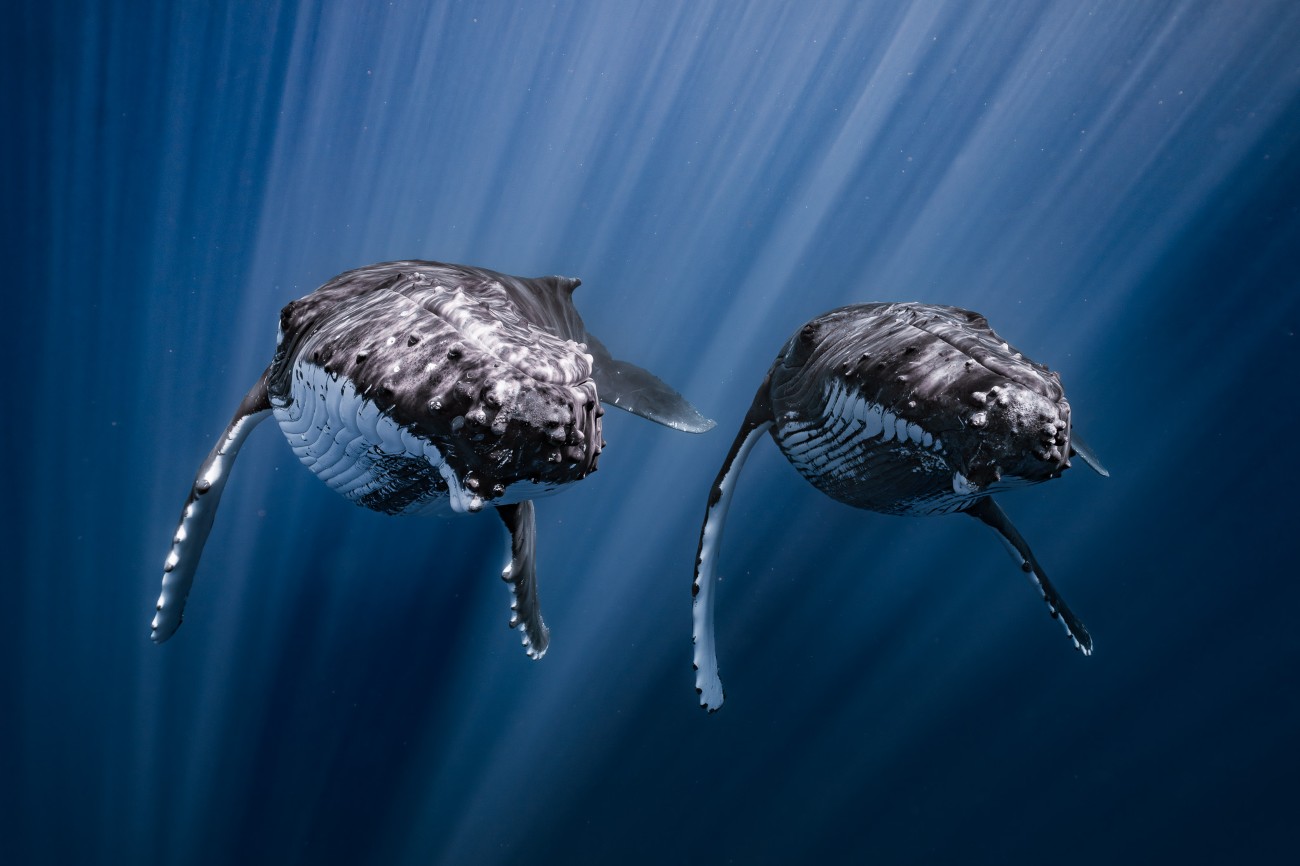

Photographer: Yuka Takahashi
Category: Young
Location: French Polynesia
“Putting myself out in the field has taught me lessons no textbook ever could,” says Takahashi. “It has also deepened my understanding of the profound biophilia held by the Tahitian people on the island of Mo’orea. These two humpback whales are always seen together, and I was fortunate to capture this rare moment of synchronicity. To me, this photo reflects the strong bond between them while also revealing their playful and curious personalities.”
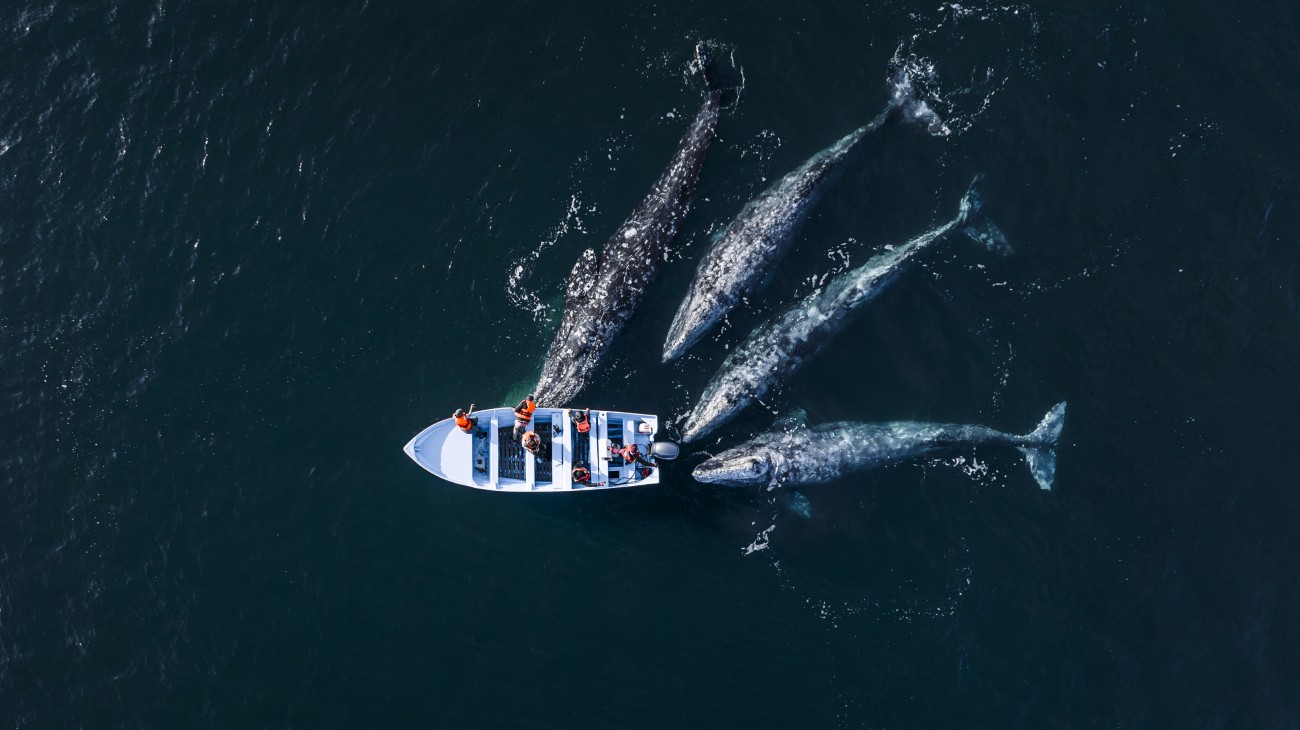

Name: Kaushiik Subramaniam
Category: Human Connection
Location: Mexico
“The behaviors exhibited by grey whales in their mating and calving lagoons in Baja California, Mexico, are unlike anything else seen around the world,” says Subramaniam. “They have a remarkable curiosity, actively approaching small fishing skiffs to see what is happening. I shot this on an incredible morning, when we had over 20 whales around our boat. The four that you see in this image were the initiators, after which all the others wanted in on a piece of the human action. To this day, this remains the most incredible wildlife interaction I have ever had.”
Selected from thousands of photographs, they span seven categories.
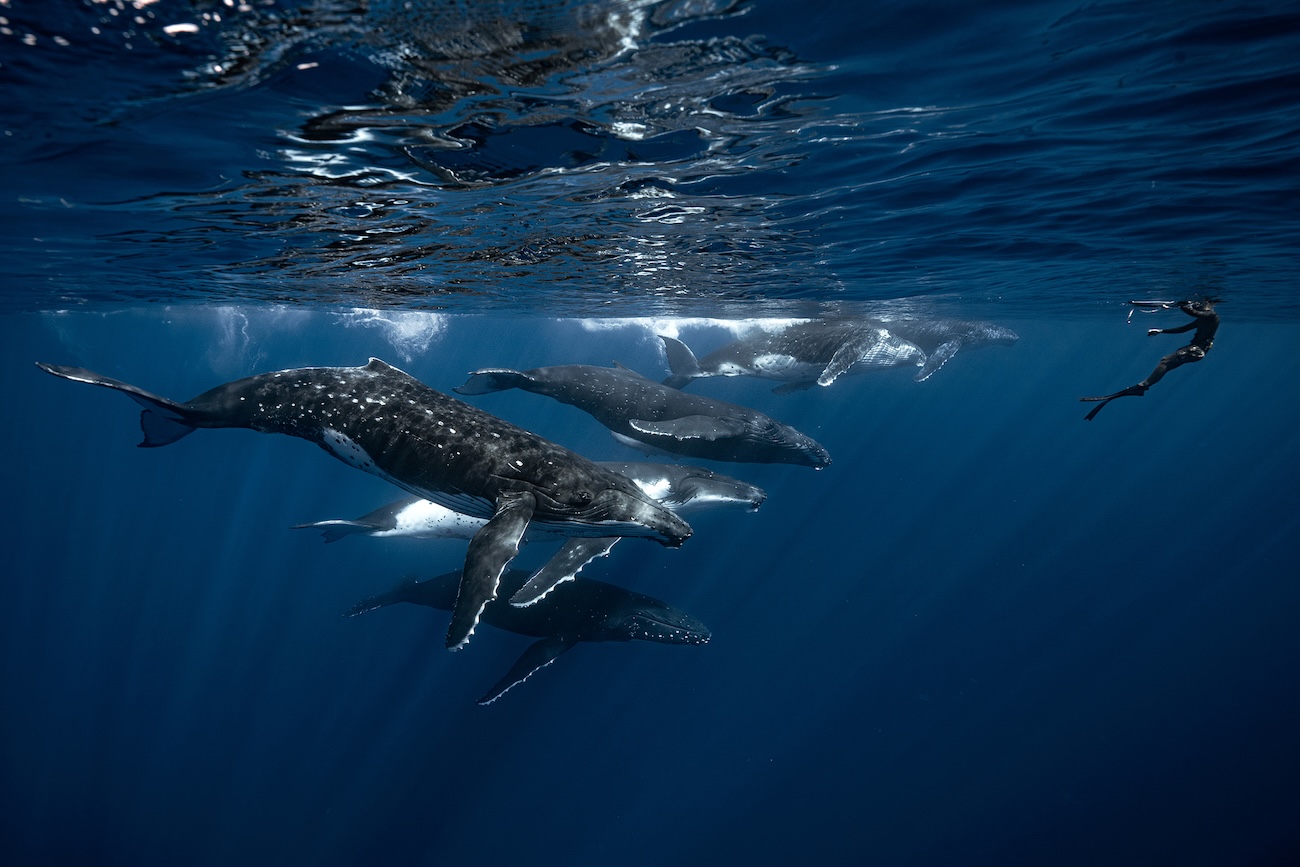

Name: Alvaro Herrero
Location: French Polynesia
“A whale watching guide observes humpback whales in French Polynesia, maintaining a respectful and prudent distance,” says Beltran. “Personally, I have very few photographs with people and wildlife because I prefer to photograph animals in their natural environment with minimal interference. I believe that responsible imaging and behavior are crucial to preserving the integrity of wildlife. I share this photograph to promote a message of respect and responsible observation.”
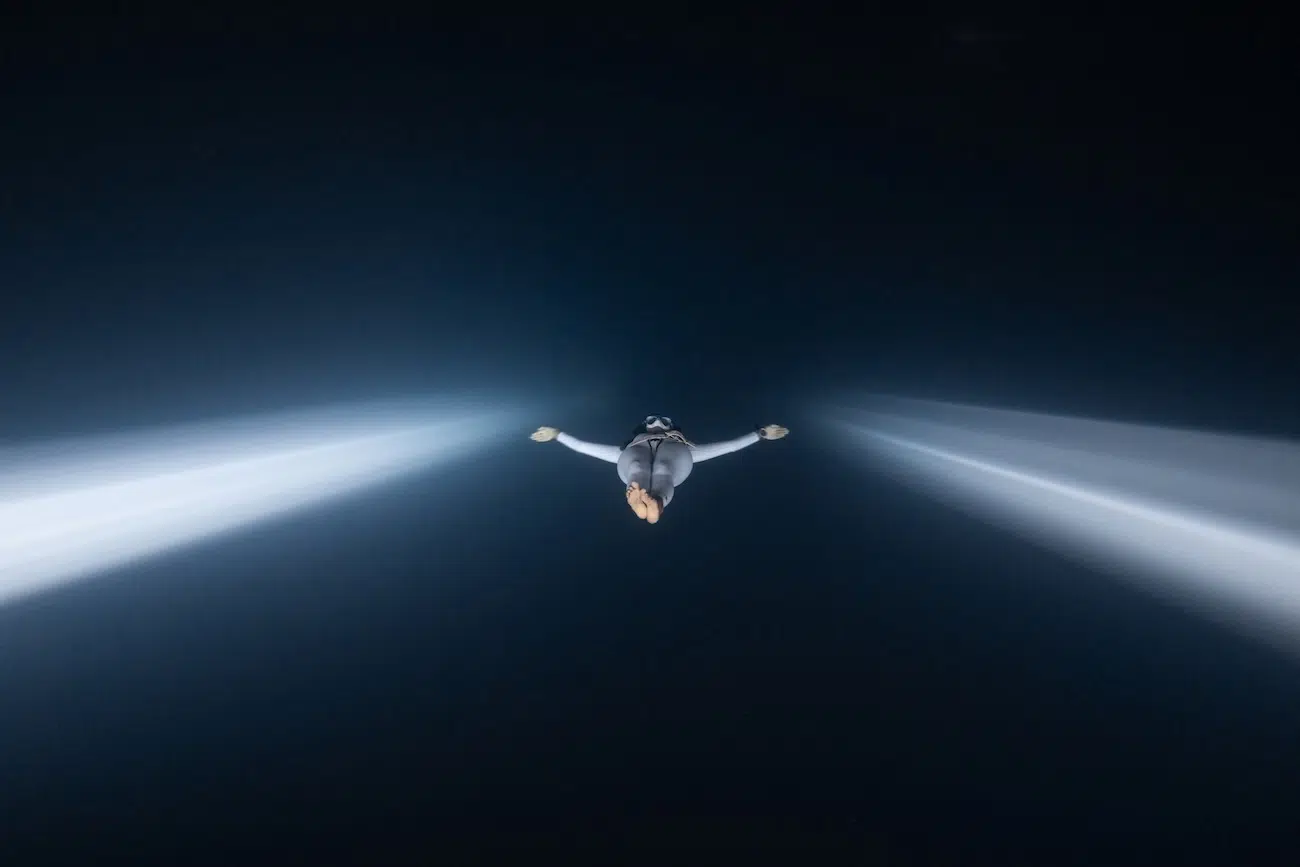

Name: Daan Verhoeven
Location: Mexico
“Freediver Surya Lecona Moctezuma dives down in between light beams in a Mexican cenote,” says Verhoeven. ”I was looking for the contrast between not just the light and dark areas, but the sudden appearance of linear geometry in a natural setting, so I asked Surya to dive right in the middle of the beams. I dived after her, positioning myself directly above.”
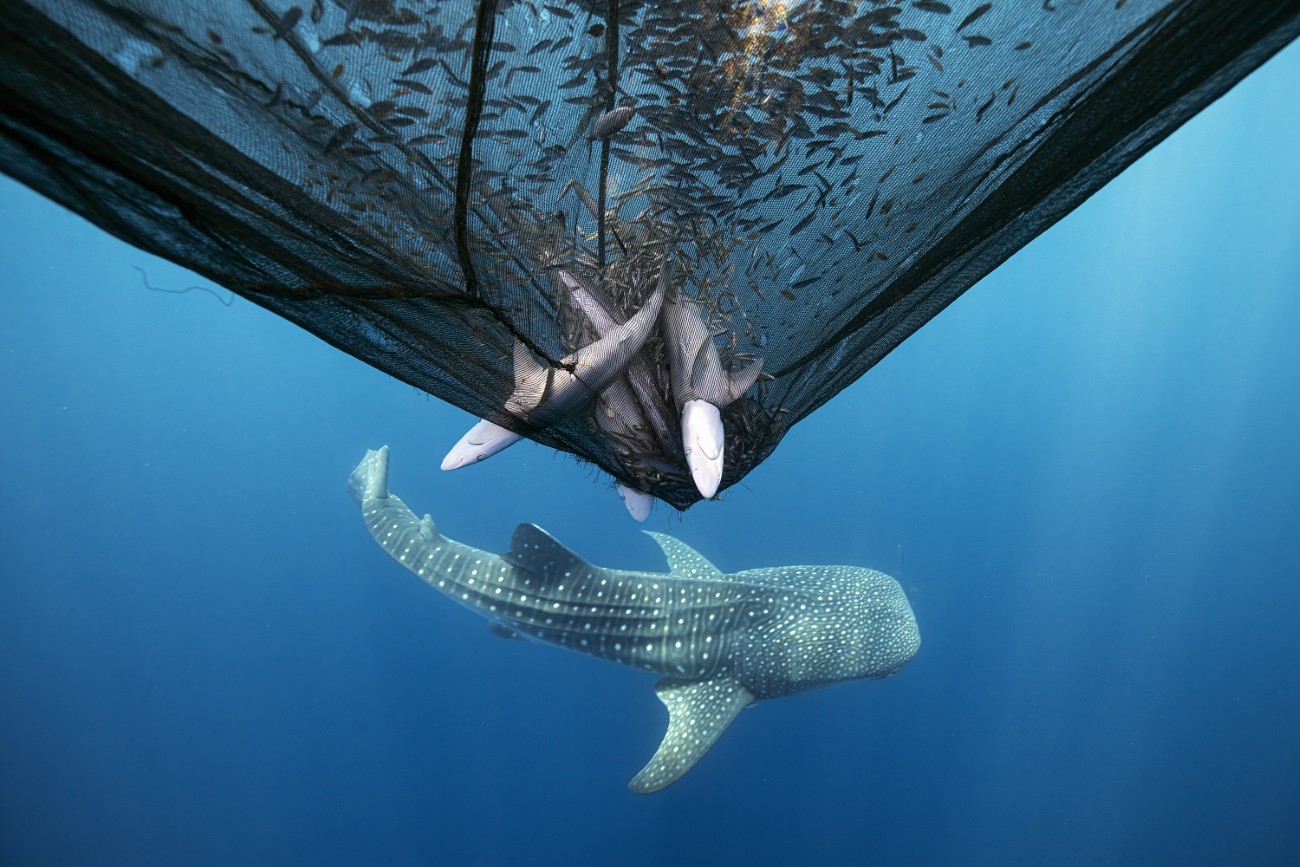

Photographer: Daniel Flormann
Category: Impact
Location: Indonesia
“Fear, fuelled by films like Jaws, blinds us to the truth: more than 100 million sharks are killed each year by humans—many as accidental bycatch,” says Flormann. “I captured this image in West Papua, where three sharks died in a net meant for anchovies. Nearby, the half-cut-off caudal fin of a whale shark tells another sad story of human impact. Sharks are essential to ocean balance, yet we are driving them toward extinction. This moment is a quiet plea: to see sharks not as danger, but as endangered—and worth saving.”
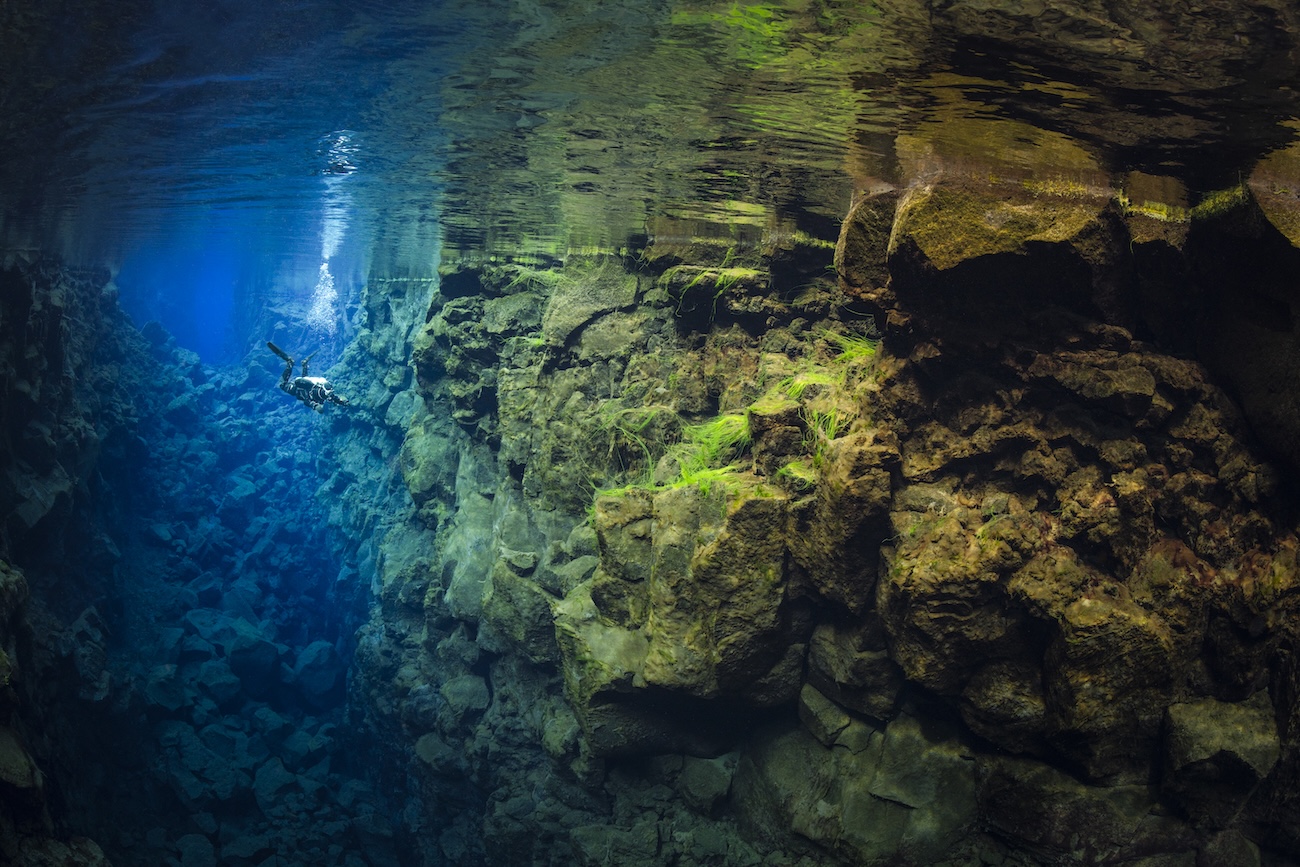

Name: Byron Conroy
Location: Iceland
“Silfra fissure is a ‘visibility wonderland,’” says Conroy. “It is the ultimate wide angle ambient light shooting destination. Visibility extends to more than 100 meters and the fissure looks completely different depending on the time of day and the time of year. My favorite time is spring when we get angled light and the first growth of the green algae.”
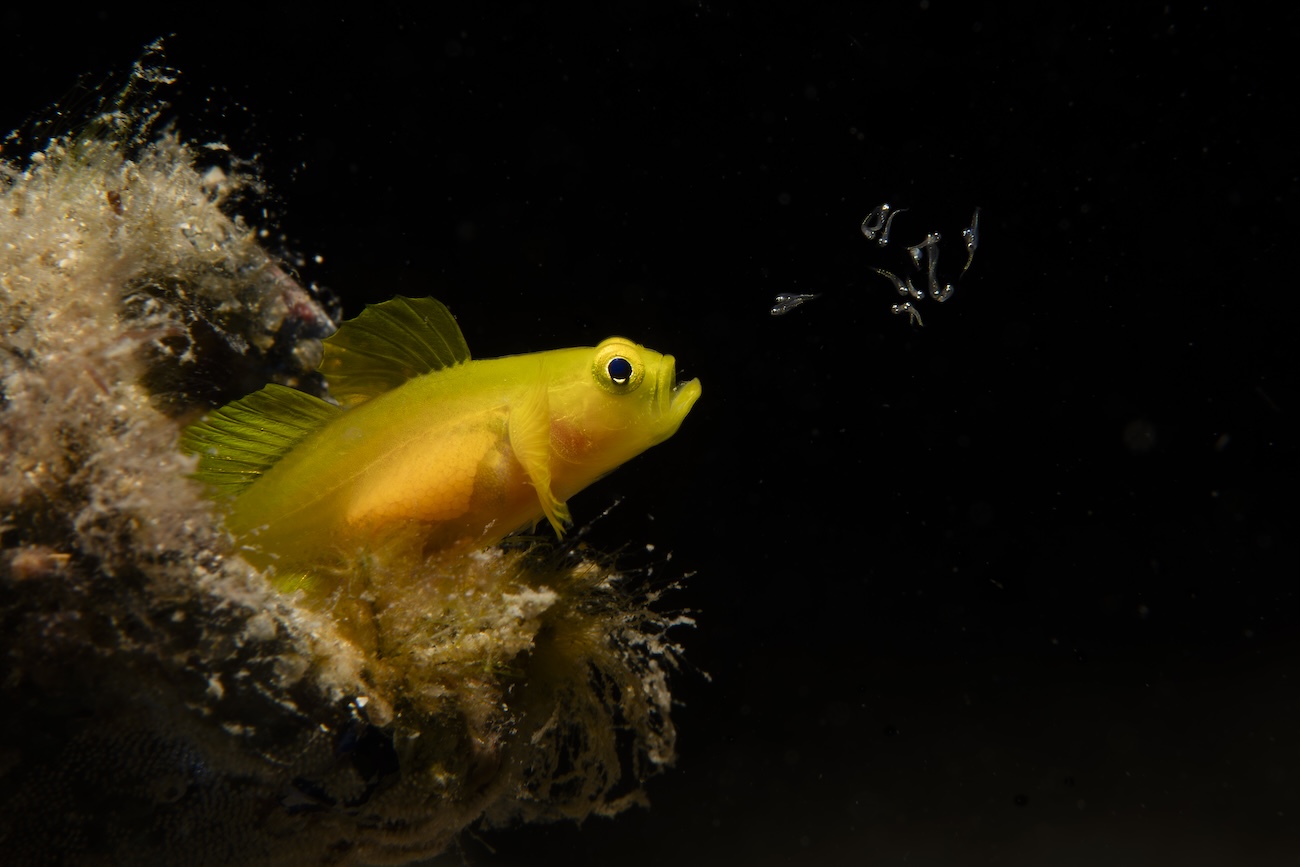

Name: Takumi Oyama
Location: Japan
“This photo shows the larval dispersal behavior observed during the hatching of the yellow pigmy goby,” says Oyama. “In gobiid fishes, male parental care is common, but unusually, in the yellow pigmy goby, females also participate in parental hatching care. This individual is a female, releasing newly hatched larvae into the water column from her mouth.”
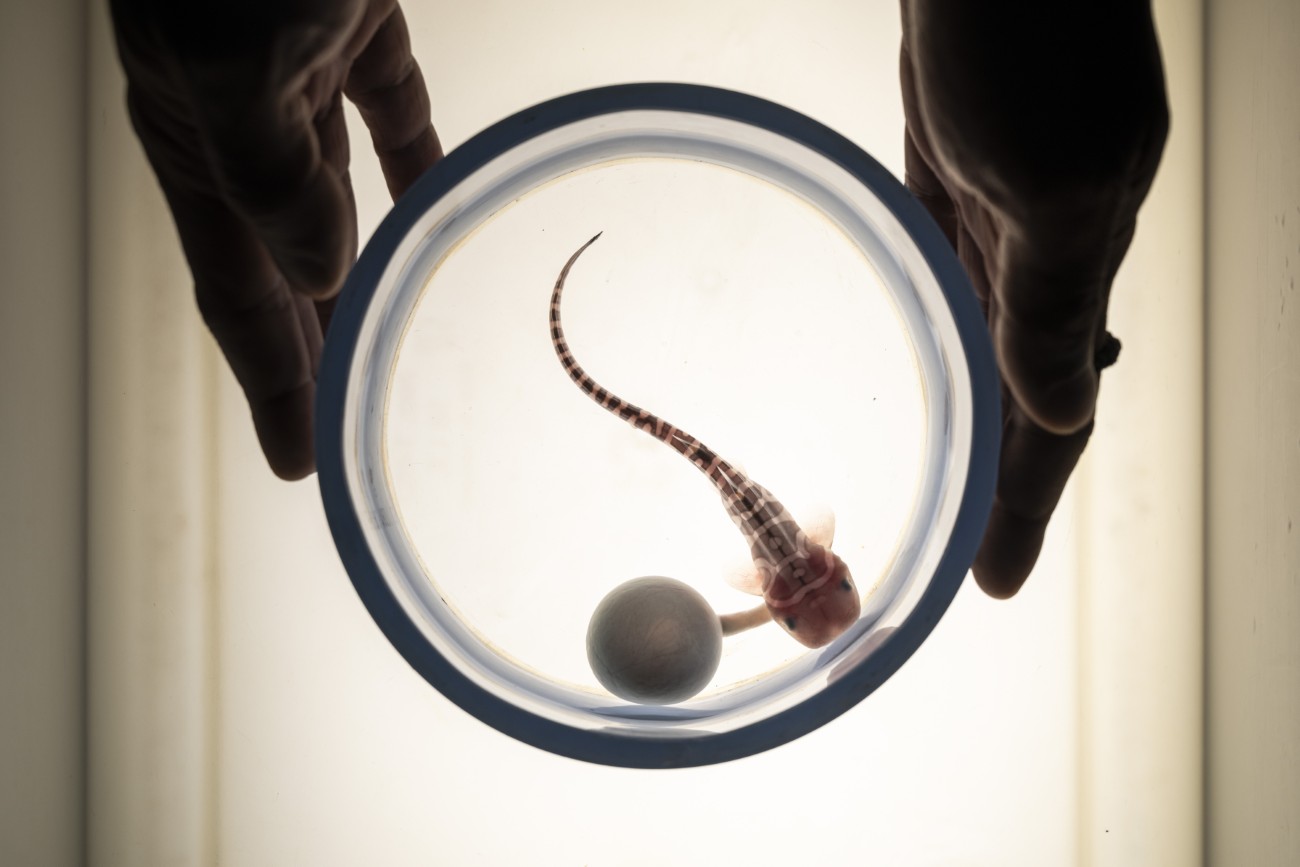

Photographer: Sirachai Arunrugstichai
Category: Hope
Location: Thailand
“An aquarist holds a glass jar with an early-stage embryo of an Indo-Pacific Leopard shark (Stegostoma tigrinum), its egg case removed for a rearing experiment at Aquaria Phuket, one of Thailand’s largest private aquariums,” says Arunrugstichai. “Since 2023, the aquarium’s staff-driven breeding program has produced over 40 pups of this Endangered species, listed on the IUCN Red List. Aquaria Phuket now works with the Department of Marine and Coastal Resources, ReShark, WildAid, Ocean Blue Tree, and private partners on the StAR (Stegostoma tigrinum Augmentation and Recovery) Project Thailand, reintroducing these sharks to the wild, beginning August 2025.”
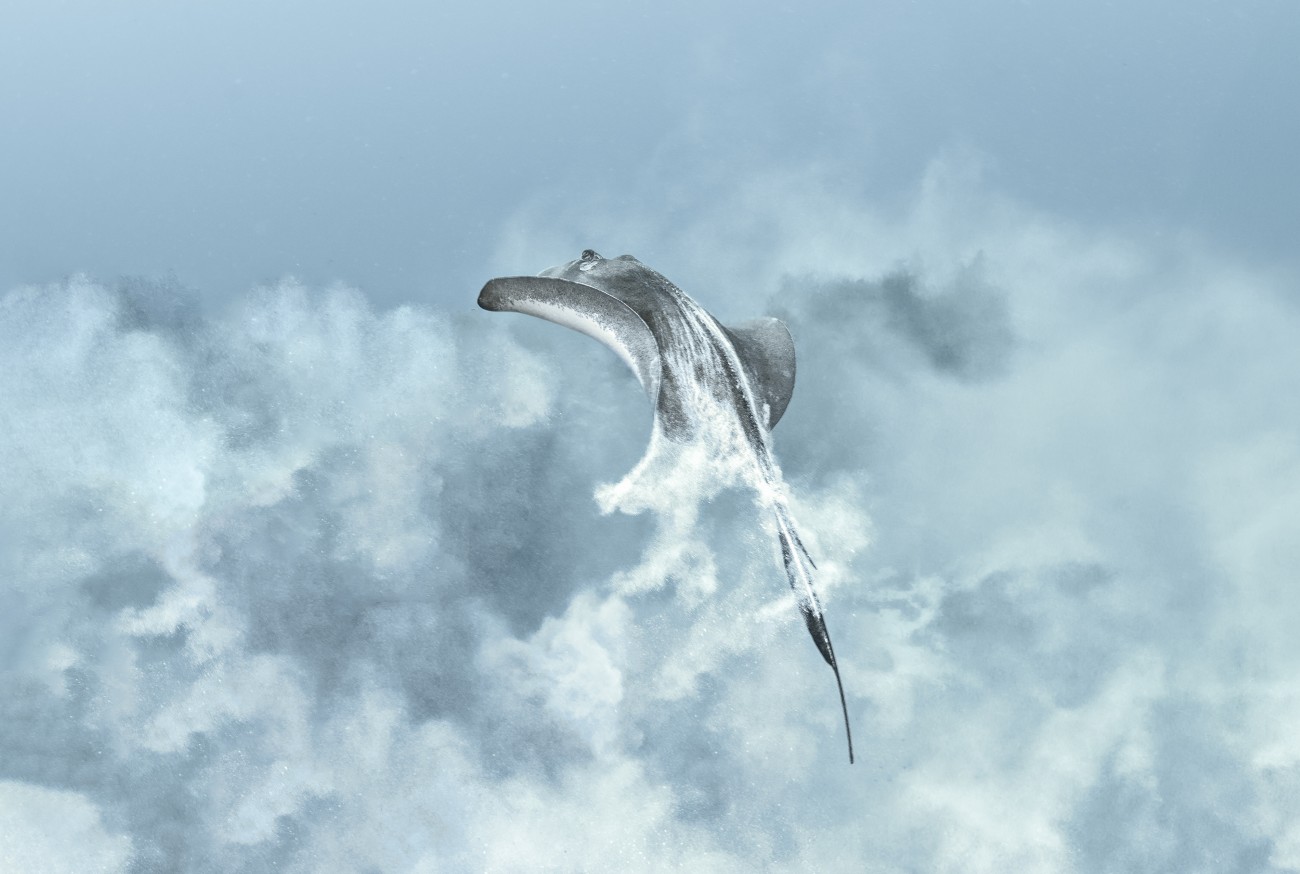

Photographer: Ysabella Coll
Category: Fine Art
Location: Mexico
“With a powerful sweep of its pectoral fins, a stingray vanishes into the blue, leaving behind a swirling cloud of sand,” says Coll. “This dramatic burst isn’t just beautiful—it’s a survival tactic. The stingray’s sudden movement disturbs the seafloor, creating a dense visual barrier that confuses predators and conceals its escape. In a single graceful motion, it demonstrates a remarkable adaptation for life on the ocean floor—where defence, camouflage, and movement come together in a fleeting but unforgettable display.”


Name: Gergo Rugli
Location: Australia
“Captured on a crisp winter morning at Bronte Beach, this image was the result of a rare alignment,” says Rugli. “A powerful southerly swell met strong offshore winds under a soft morning light. I used a slow shutter speed to capture the wave’s motion in a painterly blur while keeping the surfer sharp. This technique allowed me to freeze both chaos and grace in one frame. The title of this image is ‘Melchizedek.’ referencing the mysterious old king from The Alchemist, who, like this surfer, moved with surprising vitality and purpose.”
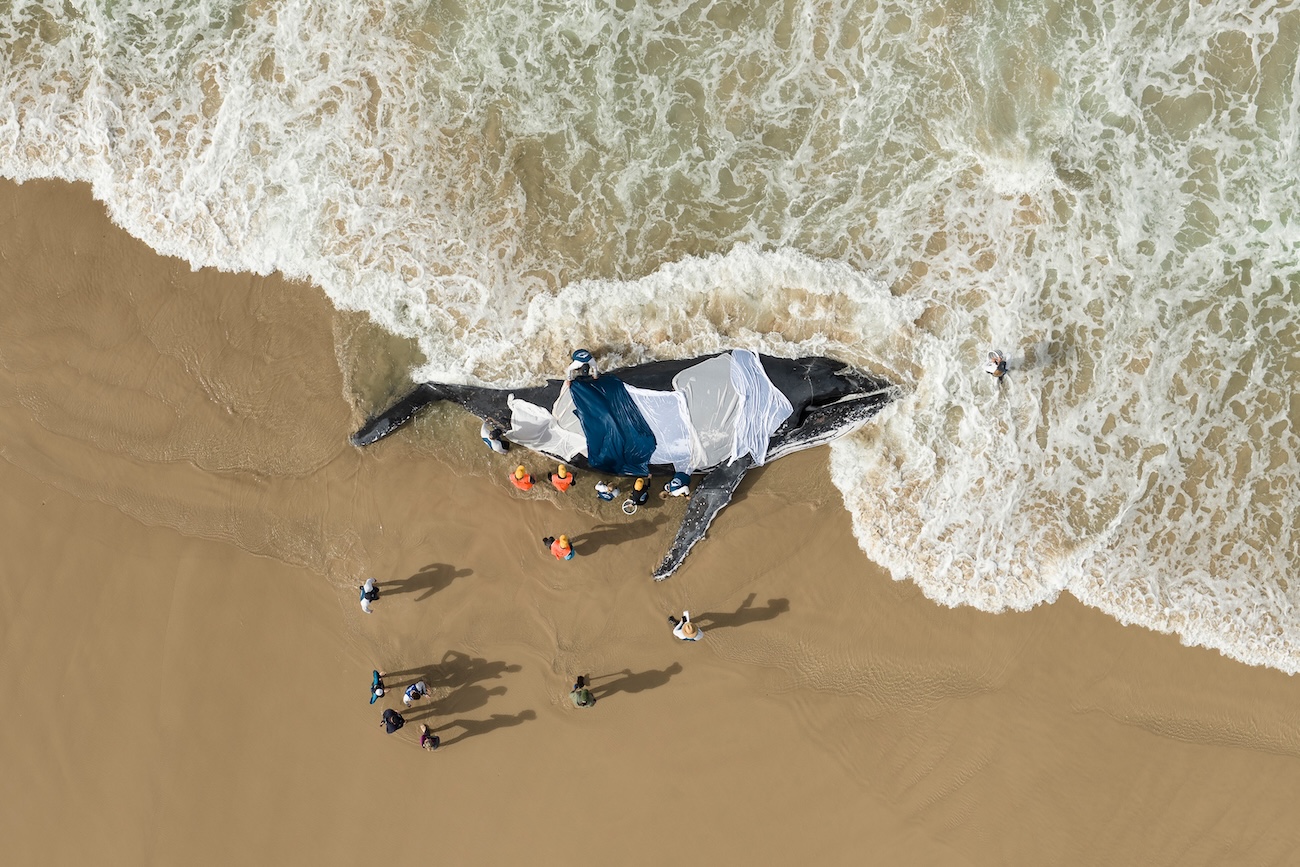

Name: Craig Parry
Location: Australia
“In the early hours of July 1st, we received a call about a stranded humpback whale,” says Parry. “Wildlife veterinarian Steve Van Mill quickly assessed the situation and contacted SeaWorld Marine Rescue and other key agencies to coordinate a response. For 15 hours, rescue teams and the local community worked tirelessly in a unified effort to save her. Sadly, despite their dedication, she could not be saved. While the outcome was heartbreaking, witnessing the collaboration and compassion shown by multiple agencies and volunteers was incredibly moving—a powerful reminder of what can be achieved when people come together with a shared purpose.”
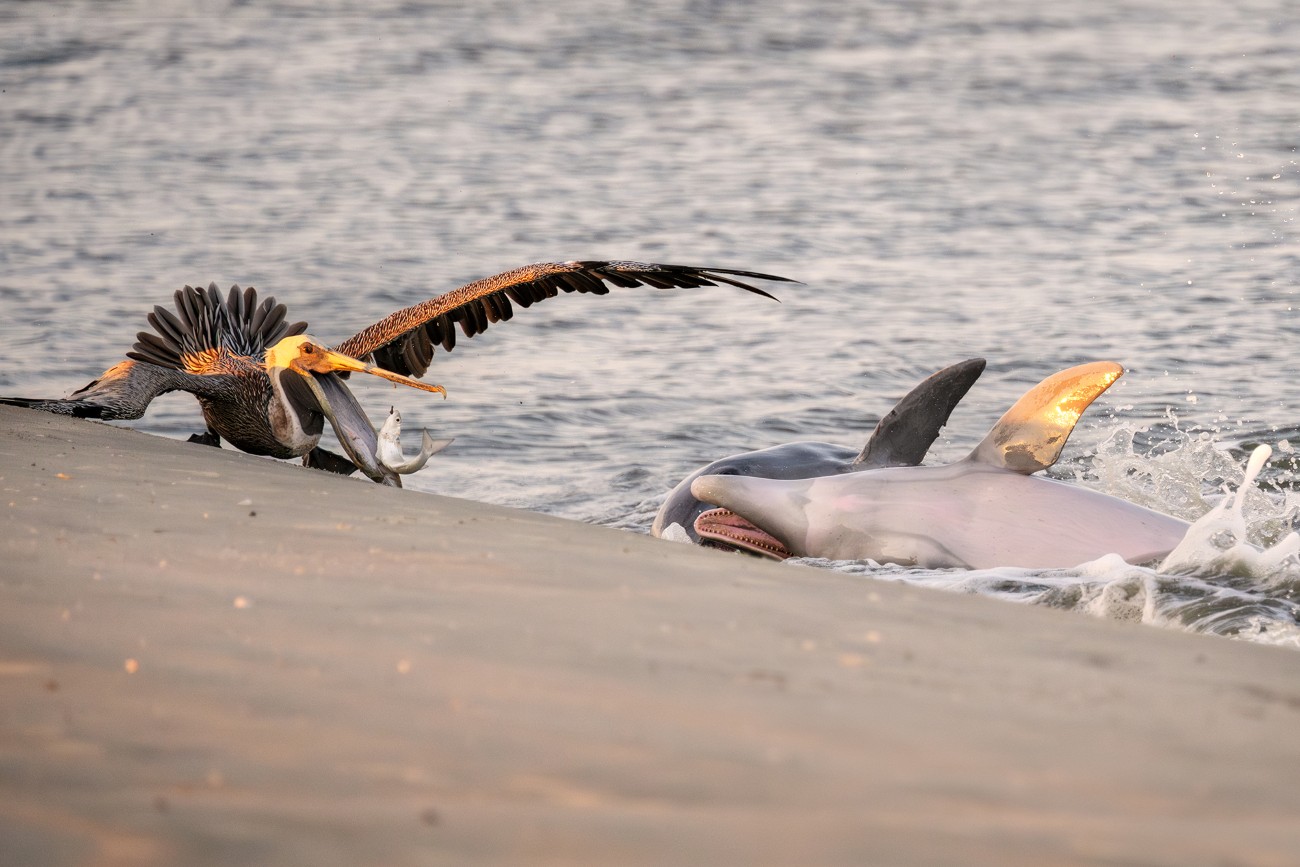

Photographer: Kat Zhou
Category: Wildlife
Location: USA
“An opportunistic pelican swoops in to steal a fish from strand-feeding dolphins. “When dolphins strand-feed, they corral baitballs of fish and rush them onto the shore,” says Zhou. “Pelicans usually lurk nearby, hoping to take advantage of an easy meal. Following the pelicans is usually a good indicator of where along the beach the dolphins might strand next. Though there are around 350 dolphins that call South Carolina home, this rare strand feeding behavior is only performed by a few members of one pod.”
The grand prize winner, as well as the category winners, will be announced in September.
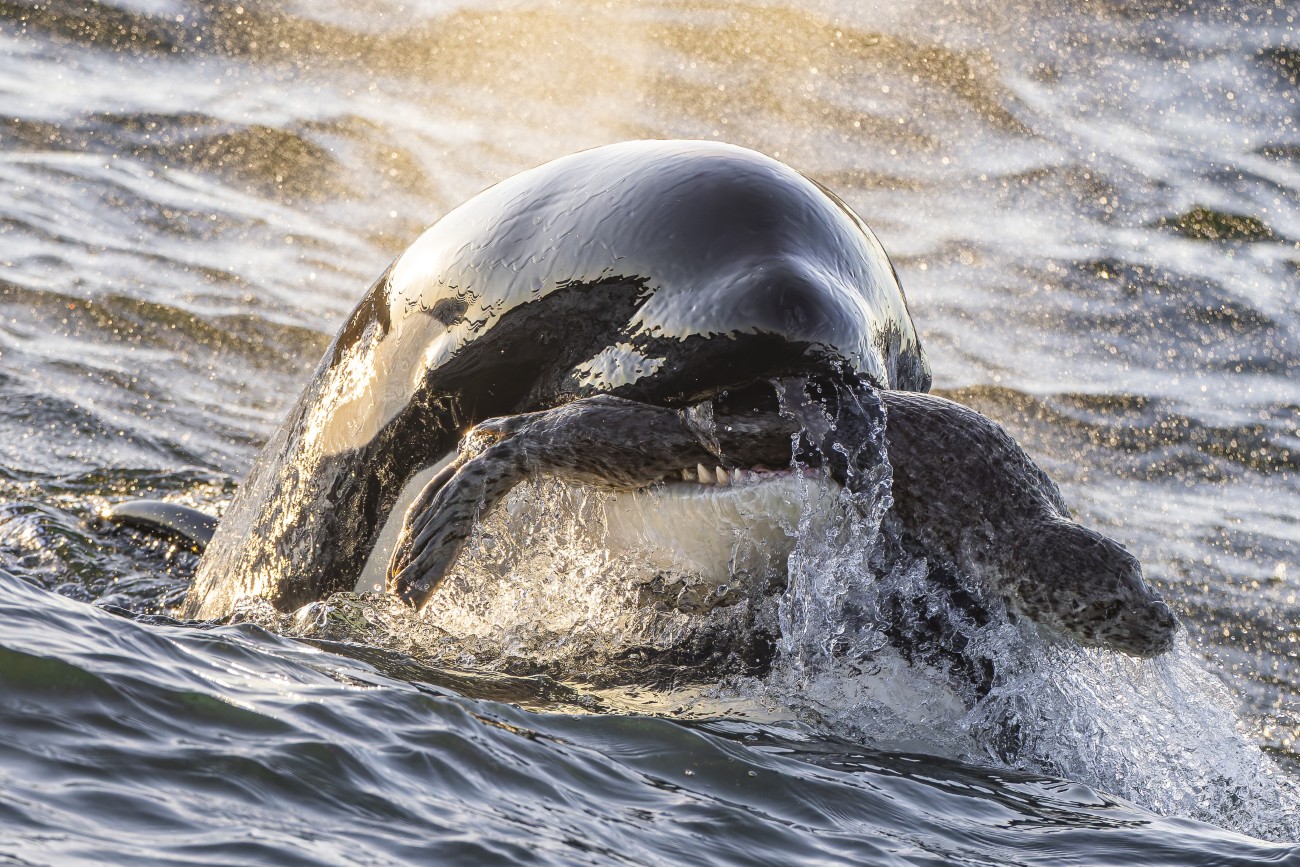

Photographer: Yifan Ling
Category: Wildlife
Location: USA
“This photo, taken on July 13, 2024, captures one-year-old Bigg’s orca T065B3—known as ‘Rook’—near Bird Rocks, WA,” says Ling. “Against the glowing sunset, Rook proudly displays a harbor seal he found while his family patrolled nearby and later helped him capture. At this age, orcas typically rely on milk and rarely hunt alone, making this moment especially impressive. His emerging skill highlights the ecological richness of the Salish Sea, where both harbour seal and Bigg’s orca populations have rebounded thanks to the Marine Mammal Protection Act of 1972—a testament to the impact of long-term conservation efforts.”
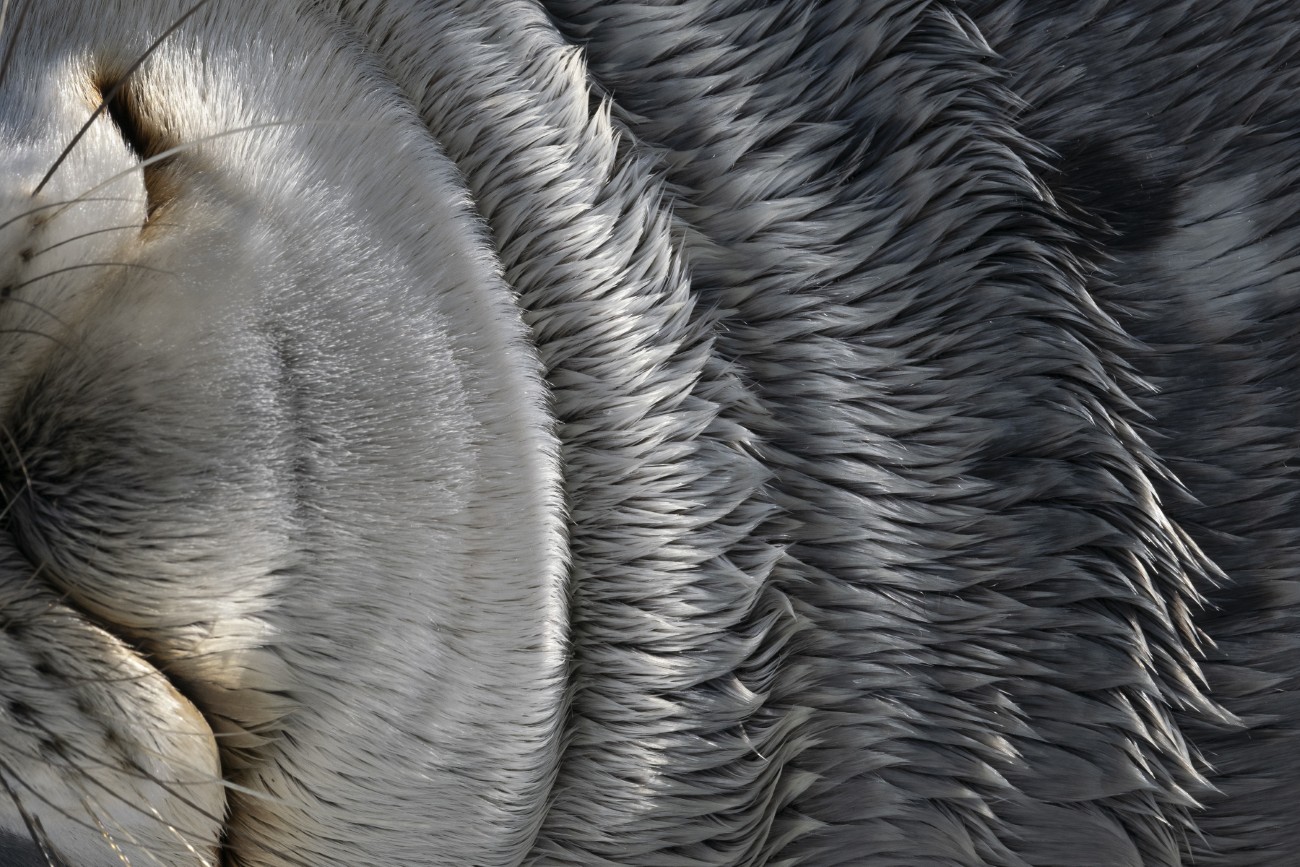

Photographer: Scott Portelli
Category: Fine Art
Location: Antarctica
“Weddell seals thrive in the harshest environment on the planet,” says Portelli. “These large mammals, distributed throughout Antarctica, have a thick layer of fur and blubber that act both as a food reserve and insulation. The finely packed fur allows them to survive in temperatures as low as -60 degrees Celsius. This image was taken after this seal had hauled itself out of the water and onto the ice floe to rest. It would later return to the icy depths of Antarctica to hunt.”
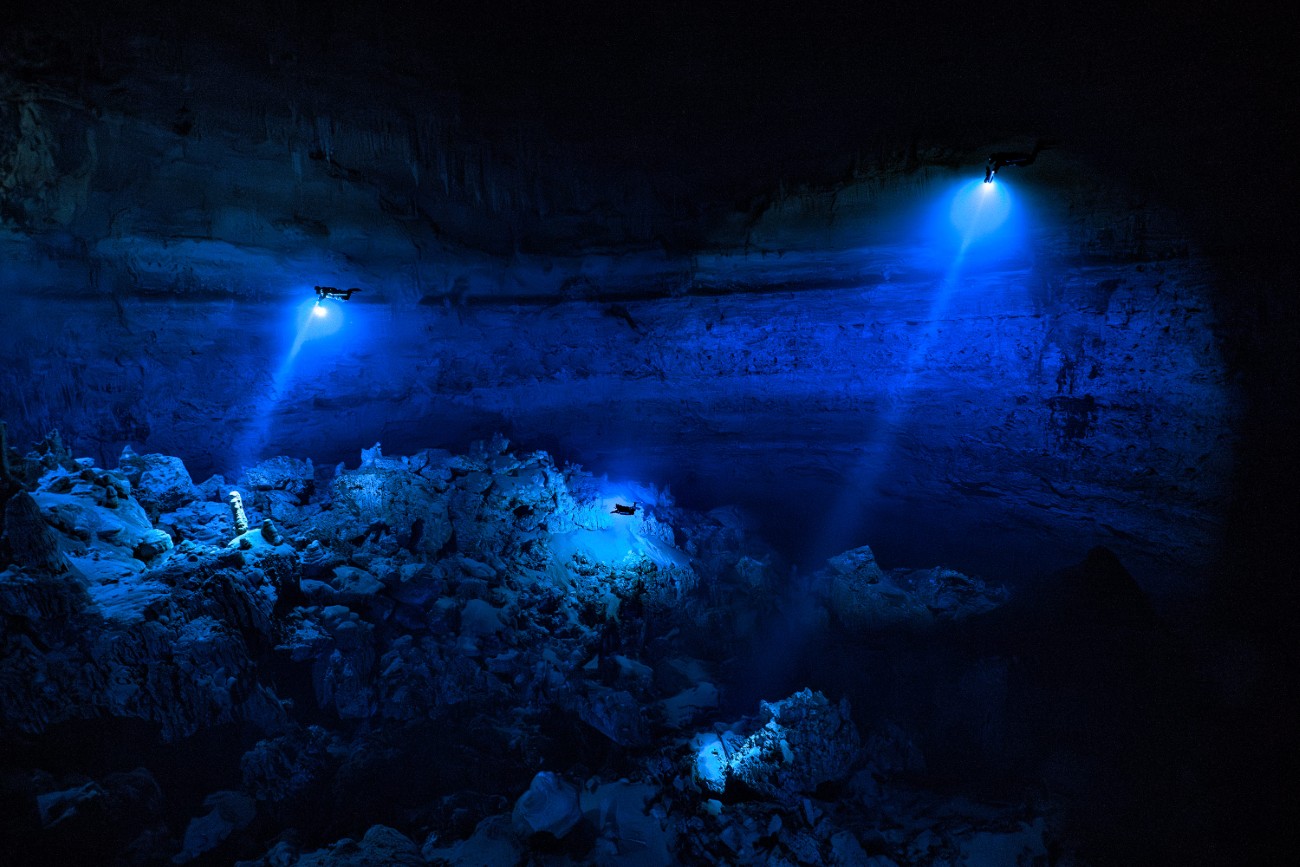

Phtographer: Alex Dawson
Category: Adventure
Location: Mexico
“This very unique cave, Yab Yum, is the largest water-filled sinkhole ever documented, close to 100 in diameter and more than 70m deep,” says Dawson. “You hit the saltwater at around 15m depth. The stalactites and stalagmites in this enormous space are huge. To reach Yab Yum, you must first drive deep into the jungle on dirt roads, followed by about 40 minutes on off-road trails that are accessible only by large-wheel 4×4 vehicles. Then finally, you need to carry all your diving gear through dense jungle, and after that, it’s a 60-minute cave dive to get to this unique location.”
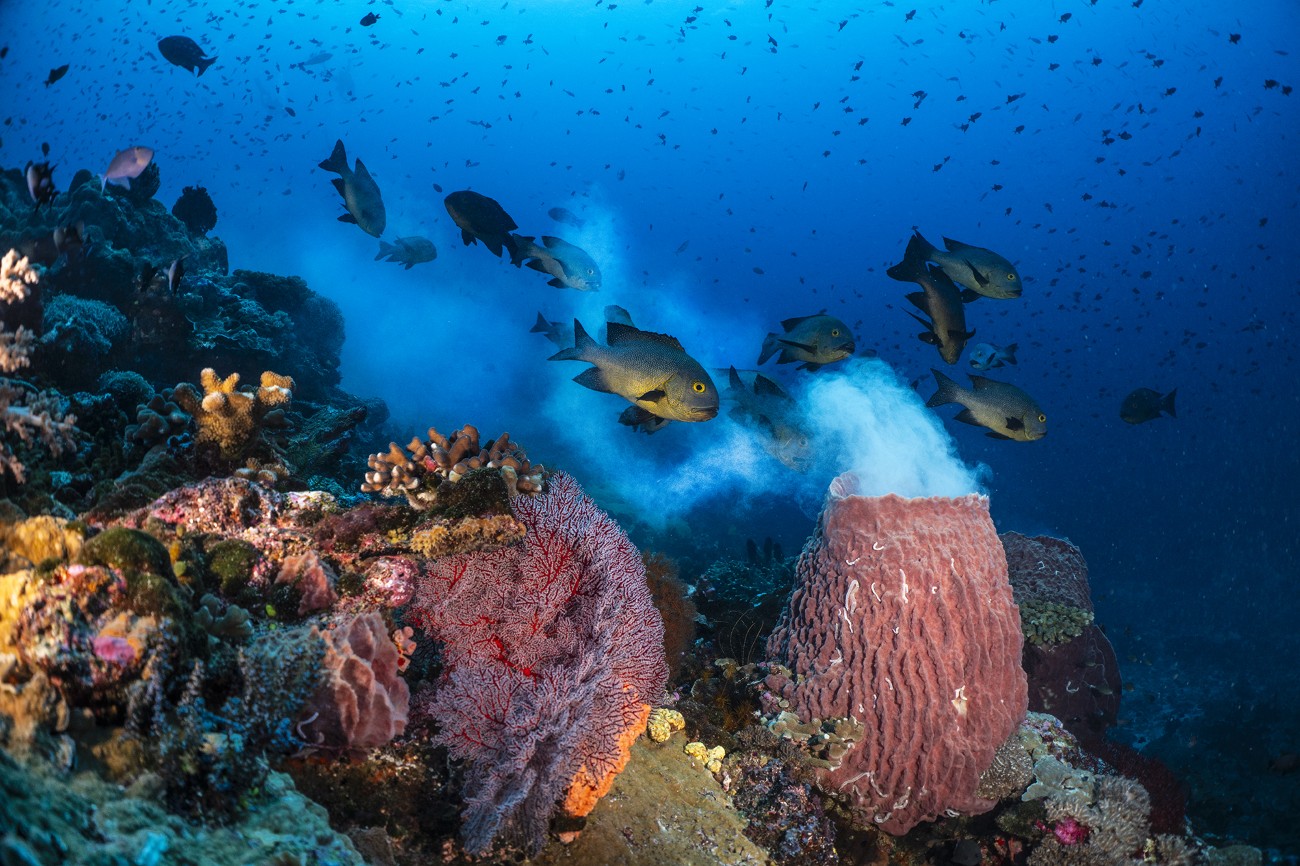

Photographer: Aaron Sanders
Category: Hope
Location: Indonesia
“Clouds of white spawn billow from a giant barrel sponge, a rare and fleeting event that breathes new life into the reef. Surrounding the sponge, a frenzy of Midnight Snappers, feast upon the rising plumes. Mouths agape these opportunistic feeders take turns consuming the nutrient-rich spawn, plunging into the white clouds, gorging themselves. “Capturing this image was no simple task,” says Sanders. “The Midnight Snappers, initially wary of my presence, kept their distance, hesitant to approach the sponge while I was nearby. I had to remain perfectly calm and still, patiently waiting for them to grow comfortable enough to circle the sponge. Over time, my presence became just another part of their environment, and they began to feed freely, allowing me the opportunity to frame this intricate feast.”

















